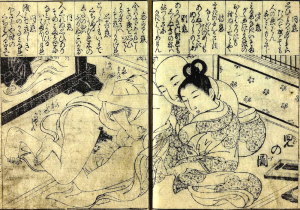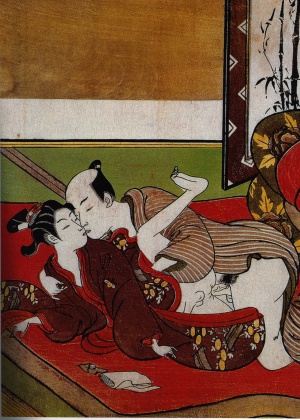(Boylove Documentary Sourcebook) - On the Content and Background of 'Kōbō Daishi's Book' by Mitsuo Sadatomo

From "Kūkai and the Tradition of Male Love in Japanese Buddhism" by Paul Gordon Schallow, in Buddhism, Sexuality, and Gender, edited by José Ignacio Cabezón (Albany: State University of New York Press, 1992). Footnotes omitted.
Note: Kūkai (空海), also known posthumously as Kōbō-Daishi (弘法大師, The Grand Master Who Propagated the Buddhist Teaching), 774–835, was a Japanese Buddhist monk, civil servant, scholar, poet, and artist who founded the Esoteric Shingon or "mantra" school of Buddhism.[1]
One of the earliest surviving manuscripts—dated 1598—to state a connection between Kūkai and male love is Kōbō Daishi’s Book. The use of Kūkai’s posthumous name in the title indicates that the connection was already well established, and that Kōbō Daishi is used largely as a byword for male love. The preface of the brief work describes how a layman goes into seclusion to pray to Kōbō Daishi for instruction in “the mysteries of loving boys in Japan” (nihon shudō no gokui). On the seventeenth day of the man’s austerities, Kōbō Daishi appears and agrees to present him with a one-volume book explaining the love of boys, the basics of which “even monkeys in the hills and fields can comprehend.” The text speaks of the “mysteries” of loving boys, implying a connection with the esoteric mysteries of True Word Buddhism. The fact that the preface identifies the book as personally transmitted by Kōbō Daishi substantiates the primary importance of the relationship between master and pupil in True Word Buddhism and, in a sense, legitimizes the book’s contents.
Kōbō Daishi’s Book, divided into three sections, claims to reveal secret teachings regarding the love of boys. The first section describes hand positions used by young acolytes to communicate their feelings to priests; the second section advises priests on how to evaluate an acolyte’s emotions by observing him closely; and the final section describes methods of anal intercourse. The categories—hand positions, observations and penetration—bear a close resemblance to the four classes of Indian tantras associated with looking, touching, embrace, and penetration.
Part One
Part One decodes ten hand signals. The concern with positions of the hands and their meaning mimics, and possibly parodies, the holy hand positions (mudrā) that were an integral part of True Word teaching and religious practice. Priests and acolytes communicated their sexual feelings in the esoteric idiom of hand positions.
1. If an acolyte clenches his fingers—from the index finger to the little finger—it means “You are the only one I love.”
2. If an acolyte clenches both hands completely except for one thumb, it means “I acknowledge your love and will make myself yours to do with as you please.”
3. If an acolyte touches the index and middle finger to his thumb, it means he wants to see you.
4. If an acolyte flips the tassle of his fan, it is an invitation to visit.
5. If an acolyte forms a circle with the index finger and thumb on both hands, it means “Tonight.” If he uses the middle finger, it means “Tomorrow night.” And if he uses the ring finger, it means “Some other time.”
6. If an acolyte touches the middle finger and ring finger to his thumb on both hands, it is an invitation to come visit.
7. If an acolyte touches the ring finger and little finger to his thumb, it means he wants to tell you something but cannot because people are watching; he’ll try again the next night.
8. If something will prevent his coming as promised, he will touch the ring finger to his thumb on both hands.
9. If an acolyte touches the index and little fingers to his thumb, it means he will come again tomorrow night.
10. If an acolyte tugs at your sleeve, it means he definitely wants you to visit.
Part Two
Part Two instructs priests on seven ways to observe an acolyte so they can tell whether he is ready for lovemaking; and, if he is not, how to arouse him and make him ready. Several of the instructions are accompanied by twenty-one syllable Japanese poems (waka) that illustrate the lesson. The most important quality a priest looks for in an acolyte is nasake, an empathetic sensitivity to love. When a boy possesses this sensitivity, seduction is hardly necessary; without it, the task of seduction is difficult, at best.
1. After an acolyte has spoken, observe him carefully. The acolyte who speaks quietly is sensitive to love. To such a boy, show your sincerity by being somewhat shy. Make your interest in him clear by leaning against his lap. When you remove his robes, calm him by explaining exactly what you will be doing.
White snow on a mountain peak
turns to pure water on the rocks
and finally flows down.As this poem illustrates, snow on even the highest mountain peak is destined to melt and flow downward. Likewise, no matter how lacking in sensitivity to the mysteries of love an acolyte may be, he can be made yours if you approach him right.
2. An acolyte may be very beautiful but insensitive to love. Such a boy must be dealt with aggressively. Stroke his penis, massage his chest, and then gradually move your hand to the area of his ass. By then he’ll be ready for you to strip off his robe and seduce him without a word.
I gaze up at the distant top of a cedar tree;
the wind blows strong,
and even the cedar bends.The poem illustrates that even a proud heart will yield if the effort is strong enough.
3. It is best to deal gently, not aggressively, with a gentle-hearted acolyte. Quietly put him at ease, and then penetrate him.
I gaze up at the quiet moon at Isobé
and my heart, too, grows calm.4. If an acolyte practices martial arts, be sure to praise his swordsmanship. Then tell him some warrior tales. Things will proceed naturally from there.
Before snow accumulates,
it is shaken off the branches;
in a windy pine, snow breaks no limbs.As this poem illustrates, if snow is shaken off a pine before it has a chance to build up, it will not accumulate to the breaking point. Likewise, an acolyte’s resistance should not be allowed to accumulate but be met as it comes; this is the only way to success.
5. If an acolyte is known to like birds, talk about birds—even if you hate them—as if you shared his interest. To an acolyte who likes to study, talk about his studies. After he opens up, you can do what you will with him.
6. The greatest pleasure is to proceed without resistance with an acolyte who possesses a great sensitivity to love.
7. If an acolyte is too shy to show himself to you, delay by plucking the hairs of your nose and then try again.
Part Three
Part Three concerns final consummation of the seduction in the form of anal intercourse with the acolyte. Seven positions are described in the idiom of tantric meditation postures; the sexual positions are given names evocative of those used in Buddhist texts to describe postures for meditation.
1. There is a method called skylark rising. The ass is raised in the air like a skylark rising in the sky. Insertion is painless.
2. Always keep “cut plums” on hand in case you want to attempt insertion without saliva.
3. There is a method call turned-up soles. Place the acolyte’s legs on your shoulders and penetrate him from the front.
4. There is a method called reverse drop. Insertion is from above the turtle’s tail, and should be accomplished gradually.
5. There is a method called summer moat. Press the boy’s ass to the moat of your belly as you enter. The method is painless, even for a young acolyte.
6. There is a method called dry insertion. Moisten only slightly with saliva, then penetrate. The method causes severe pain.
7. The method for initiation is called tearing the hole. In this method, a man with a large penis penetrates in one thrust without lubrication. The method causes severe pain.
Conclusion
In the conclusion, the author attributes the teachings in Kōbō Daishi’s Book to Kūkai himself, conveyed to him as a reward for his religious devotion. That attribution is the central legitimizing fact of the book. The postscript to the main manuscript consists of three popular beliefs about boy love that have parallels in beliefs about women: that women with small mouths were amorous, and that facial features gave clues to the shape of a woman’s genitals.
I received this book of secret teachings from the founder of boy love in Japan, Kōbō Daishi, under the condition that I not show it to anyone. Signed Mitsuo Sadatomo, a hermit in Satsuma Fief.
1. An acolyte with a tiny mouth is best. They say that those with large mouths do not have tight asses.
2. It is best if the ass is slightly reddish in color. A dull ass may contain feces.
3. One look at a boy’s face will tell you what his ass looks like.
I have taken the liberty of adding the above three lines. Submitted with humble respect by Mitsuo Sadatomo, in the third year of Keichō [1598], third month, a felicitous day.
Kōbō Daishi’s Book bears the date 1598, well before the Genroku era (1688–1703) when books on sexuality were tinged with irony. Although not meant to be read ironically, the book nevertheless foreshadows the more modern Genroku approach to sex in the playfulness that comes through in certain passages. One such passage appears in the book’s introduction: “The love of boys began in olden times when Kōbō Daishi made a vow of love with Wen Zhou. Sentient Being (shujō) refers to a man and boy who fall in love with each other, become fast friends, and make a vow of brotherly love; the phenomenon is recorded in many books. Because Kōbō Daishi began the practice of this way of love, it has been preserved all these years and continues to the present day in both Japan and abroad.”
Sentient Beings (shujō) is a proper Buddhist term referring to all living things, but here it is defined as the love of boys (shudō). The confusion of the two terms may have been meant to elicit a laugh from the book’s readers. If that is the case, what necessitated this linguistic inventiveness? The use of religious language and symbols in Kōbō Daishi’s Book may represent not just religious heterodoxy but a challenge directed at a society defined by Confucian ethical constructs that discouraged sexual activity as socially disruptive in all but its most conventional forms.

References
See also
- Adult friend (dictionary)
- Age of attraction (dictionary)
- Bishōnen
- Boylove
- Chigo monogatari
- Ephebophilia
- Historical boylove relationships in Japan
- Loved boy (dictionary)
- Manga and anime
- Minor-attracted person (dictionary)
- Pederasty
- Pedophilia
- Samurai
- Shōnen
- The Great Mirror of Male Love (book)
- Wakashū
- Young friend (dictionary)